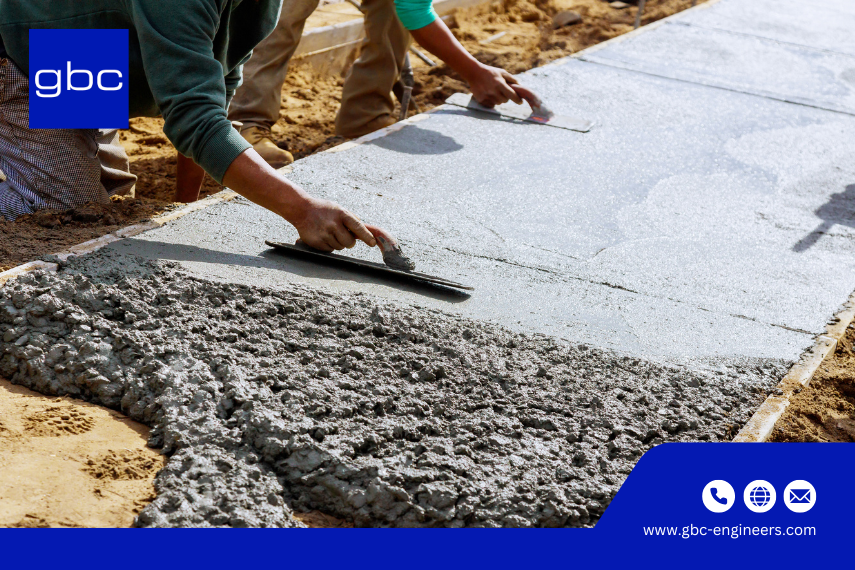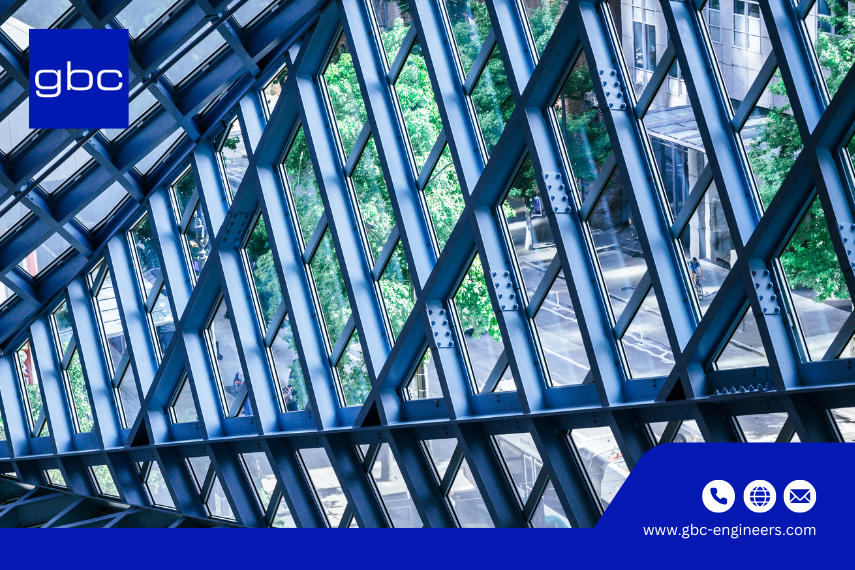As global demand for data centers surges, so does their environmental impact. Data centers are resource-intensive buildings that require substantial energy and materials to build and maintain. Consequently, the construction industry has begun to seek sustainable building materials that minimize environmental harm.
Sustainable engineering and the adoption of low-carbon, eco-friendly materials play a pivotal role in reducing greenhouse gas emissions, lowering energy consumption, and supporting a more sustainable lifestyle.
This article of gbc engineers explores how sustainable building materials are reshaping the future of data centers.
Low-Carbon Concrete Alternatives: Geopolymer vs. Carbon-Cured Solutions
The Carbon Footprint of Traditional Building Materials
One of the most widely used construction mixes globally is responsible for nearly 8 percent of global CO2 emissions. Traditional Portland cement, a major component of this material, releases substantial carbon dioxide during its production. This contributes significantly to the ongoing climate crisis and increases pressure on our planet’s natural systems. As the urgency around climate issues grows, designers, builders, and policy leaders are searching for alternatives that are both effective and planet-friendly.
Read More: How Smart Data Center UPS Design Reduces Operational Costs - gbc engineers
Geopolymer Mixes: A Low-Carbon Alternative for Modern Construction
Geopolymer building materials are redefining how we approach low-emission construction. By replacing standard cement with industrial by-products like fly ash and slag, this sustainable solution delivers comparable strength and durability while drastically cutting harmful emissions. The term "geopolymer" refers to its mineral-based polymer structure, which supports long-term resilience and promotes green building practices. As more infrastructure projects seek low-impact solutions, geopolymer options are gaining recognition in both commercial and industrial applications.
Carbon-Cured Materials: Capturing CO₂ While Strengthening Structures
Carbon-cured cement-based solutions offer an innovative path forward. During the curing process, they absorb captured carbon dioxide, effectively locking it within the material. This process not only strengthens the mix but also serves as a carbon capture method. These innovative solutions are ideal for high-performance projects such as data centers, where both structural reliability and eco-conscious performance are critical. Implementing carbon-cured materials is a step toward reducing climate threats while building smarter, longer-lasting infrastructure.
Renewable Resources: Bamboo, Timber, and Natural Wood
Natural resources such as bamboo, engineered timber, and sustainably harvested wood are leading the shift toward low-impact construction. Bamboo, celebrated for its rapid renewability and strength, is being used in structural systems and formwork. Meanwhile, timber products offer flexible and renewable solutions for framing and finishes. These biodegradable and renewable options help lower the overall carbon output of a project. When paired with low-carbon cement alternatives, these materials support a holistic green approach throughout the building’s life cycle.
Read More: How Smart Data Center UPS Design Reduces Operational Costs - gbc engineers
Green Policy and Regulatory Support for Sustainable Materials
Policy frameworks are essential for accelerating the adoption of low-impact construction practices. Governments, advocacy groups, and green certification bodies are setting standards that encourage or require the use of climate-resilient materials like carbon-cured mixes and recycled content. Programs such as LEED and BREEAM support this transformation by offering recognition for planet-friendly building techniques. These policies help protect natural systems and ensure accountability in project development across regions.
Building for Future Generations: Materials That Endure and Respect the Planet
Choosing sustainable building materials goes beyond short-term trends. It reflects a commitment to designing spaces that support human well-being and planet preservation over time. With innovations such as carbon-sequestering mixes and geopolymer-based solutions, the industry is embracing materials that align with long-term ecological goals.
When combined with responsibly sourced natural elements like bamboo and timber, these solutions offer the strength and reliability required for large-scale infrastructure, while minimizing damage to natural systems. In this way, builders are creating not only structures, but also a blueprint for a greener, healthier world.

Eco-Friendly Steel: Green Steel and Recycled Alternatives
Steel remains a vital building material in data center construction due to its unmatched strength and flexibility. However, traditional steel production is highly energy-intensive and a significant contributor to global warming through excessive carbon emissions. The growing urgency to address this challenge is transforming how industries approach materials and design.
Green steel, produced using hydrogen rather than coal, is reshaping how we think about industrial manufacturing. By drastically cutting carbon output, it enables large-scale projects to support global goals aimed at mitigating the effects of climate disruption without sacrificing durability or performance.
Recycled Steel: A Core Element of Circular Construction
Recycled steel is emerging as one of the most effective sustainable construction materials available today. It supports the circular economy by significantly reducing the need for raw material extraction and energy use. Each ton of recycled steel prevents thousands of kilograms of CO₂ from entering the atmosphere.
Used across framing, reinforcements, and facades, reclaimed structural metal minimizes waste and supports long-term infrastructure resilience. It provides a cleaner production cycle and aligns with eco-conscious procurement strategies. When implemented in data centers, recycled steel helps companies fulfill their environmental goals while maintaining structural integrity.
The energy savings from repurposed steel materials are substantial—using up to 75% less energy than producing new steel—making it a strategic choice for sustainable development.
Long-Term Impact and Industry Shift
Adopting green steel and recycled steel is part of a broader industry shift toward lower-impact construction. As regulations tighten and awareness of climate change grows, developers and engineers are prioritizing materials that balance performance with reduced environmental impact.
These forward-thinking choices reflect how the industry is responding to environmental policy updates, consumer demand, and the need to curb long-term degradation caused by unchecked industrialization. Green materials are no longer niche—they are essential to how modern buildings are conceptualized and executed.
As environmental concerns rise and the construction industry adapts, leveraging alternative steel production methods and embracing innovation in materials is a powerful way to drive responsible change. These efforts not only support planetary health but also strengthen the long-term viability of critical infrastructure like data centers.
By integrating lower-carbon options into core project strategies, organizations are paving the way for smarter, greener, and more efficient builds—where every change supports a better future.

Modular & Prefabricated Materials: The Fast, Clean Construction Model
Efficiency in Construction Prefabricated components are built off-site in a controlled setting, allowing for precision, reduced waste, and lower on-site emissions. These cleaning products for the construction process simplify workflows while enhancing environmental performance.
Advantages for Data Centers Modular prefabrication supports scalability and rapid deployment—critical in the fast-paced tech industry. It also helps builders stick to eco friendly terms by reducing construction timelines and material wastage.
Means to a Sustainable End By integrating prefabricated elements into the building design, developers can deliver high-quality products that support a sustainable lifestyle without compromising efficiency or durability.
Read More: What Is Data Center Power Design? Key Components & Best Practices - gbc engineers
Energy-Efficient Insulation: Next-Gen Materials for Cooler Operations
The Importance of Insulation Insulation is a key aspect of data center efficiency. Maintaining optimal internal temperatures minimizes the need for energy-intensive cooling systems.
High-Performance Materials Aerogels offer top-tier thermal resistance while being ultra-light and space-efficient. Their performance reduces reliance on external energy sources, making them a vital part of eco friendly data center architecture.
Natural Alternatives Natural insulation like sheep wool and hempcrete not only offer excellent insulation but are biodegradable and non-toxic. These products are free from harmful chemicals and support a healthier indoor environment.
Sustainable Benefits Energy-efficient insulation leads to lower operational costs, extended equipment lifespan, and reduced emissions. Integrating these items into the design improves sustainability performance across the board.
Read More: Best Practices for Designing Firewalls in Modern Data Centers - gbc engineers
Circular Economy Strategies: Reuse, Recycle, Reduce
Understanding the Circular Economy The term "circular economy" refers to designing out waste, keeping materials in use, and regenerating natural systems. It is a fundamental component of sustainable engineering and lifestyle.
Recycled Metal and Glass Using recycled aluminum and glass significantly cuts down energy usage. For example, recycled aluminum uses up to 95% less energy compared to virgin production. These materials are commonly used in data center facades, doors, and paneling.
Adaptive Reuse Reusing structural components like beams and doors from decommissioned buildings reduces the need for new materials. Adaptive reuse not only decreases landfill contributions but also retains the embodied energy in existing materials.
Waste Management Effective cleaning and separation of construction waste like plastic, wood, and paper help streamline recycling processes. Partnering with certified recycling centers ensures responsible material handling, closing the loop in material lifecycle.
Advanced Waste Management Strategies
Material Segregation On-site segregation of construction waste into categories such as metal, plastic, and wood enhances the efficiency of recycling. Clear labeling and bin placement are essential for successful waste management.
Partnerships with Recycling Facilities Collaborating with licensed waste management companies ensures that materials are processed properly. This step supports green certification goals and reduces long-term environmental impact.
Reducing Construction Footprint Advanced waste management means lower landfill use and better material recovery. Implementing these practices helps data centers achieve sustainability metrics more easily.

Green Building Certifications: LEED, BREEAM & Beyond
LEED and BREEAM Green building certifications like LEED (Leadership in Energy and Environmental Design) and BREEAM (Building Research Establishment Environmental Assessment Method) reward the use of sustainable materials and construction methods.
Benefits for Data Centers Achieving green certifications boosts the credibility and marketability of a data center. It signals to investors, clients, and the public that the facility is committed to environmental stewardship.
Driving Broader Change Certified projects serve as models, pushing the industry to adopt more eco friendly and responsible practices. They also help normalize sustainable standards across the construction and tech sectors.
Read More: Data Center Topology Design for Cloud and Hybrid Environments - gbc engineers
FAQ
What constitutes eco-friendly building materials?
These materials have low embodied carbon, are made from recycled or renewable sources, and support sustainable lifecycles.
Can concrete really be carbon-negative?
Yes—technologies like carbon-cured and geopolymer concrete actively sequester CO₂, improving lifecycle metrics.
Is green steel ready for large-scale projects?
Yes. As with H2 Green Steel, hydrogen-based production is scaling industrially by 2026, reducing CO₂ emissions by ≈95%.
Are prefab modules as durable as site-built structures?
Absolutely. Prefabricated components meet or exceed standard codes and can be rigorously quality-controlled off-site.
How do I certify my data center with LEED or BREEAM?
Partner early with gbc engineers to integrate certifiable materials and processes, ensuring smooth certification.
Ready to Future-Proof Your Data Center?
Partner with gbc engineers to design a facility that delivers performance, reliability, and long-term value.
🌐 Visit: www.gbc-engineers.com
🏗️ Explore Our Services: Services - gbc engineers
Conclusion
Sustainable building materials are no longer a niche concept; they are essential components in designing the data centers of tomorrow. From low-carbon concrete and green steel to recycled components and advanced insulation, each element contributes to a cleaner, greener world. These materials not only reduce environmental harm but also improve performance, compliance, and long-term value.
At gbc engineers, we are proud to support this sustainable shift. Our engineering expertise integrates eco friendly solutions into every phase of construction, ensuring projects align with both environmental goals and high-performance standards. Whether it's implementing innovative materials, adhering to green certifications, or advancing circular economy principles, gbc engineers is dedicated to helping clients meet the challenges of modern construction responsibly.
Learn more about our approach and how we deliver future-ready, environmentally conscious engineering solutions by visiting our blog or contacting our team directly. Let’s build a better future—together.